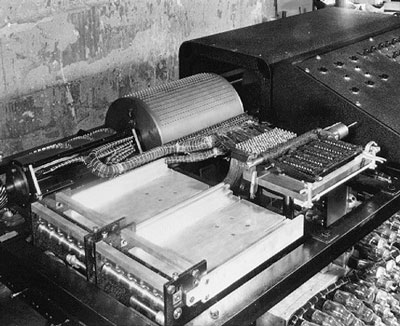
 |
Search | FAQ | US Titles | UK Titles | Memories | VaporWare | Digest | |||||||
| GuestBook | Classified | Chat | Products | Featured | Technical | Museum | ||||||||
| Downloads | Production | Fanfares | Music | Misc | Related | Contact | ||||||||
| CED in the History of Media Technology | ||||||||||||||

The origin of the electronic digital computer is often traced to this machine built by John Atanasoff and Clifford Berry at Iowa State University in 1941. The digital logic and memory of the machine were derived from the vacuum tubes at the lower right and the capacitor-studded drum at the middle. Data was fed into the system via punched cards. Atanasoff stopped further research on the computer upon joining the World War II effort in 1942.
There is still considerable debate about who can claim the invention of the digital computer. John Mauchly and J. Presper Eckert were granted a patent for the 18,000-tube ENIAC, which was completed in 1946. This was considered the first electronic digital computer for many years, but in 1974 a U.S. federal judge voided the patent after it was learned that Mauchly had spent several days studying the Atanasoff-Berry computer in 1941.
Another prominent digital computer was the Colossus which became operational at Bletchley Park near London in 1943. These machines (ten in all, each with 2000 vacuum tubes) were used to crack German Enigma codes during World War II. The Colossus can righty claim the honor of being the first computer to perform practical work. The Colossus machines remained shrouded in secrecy for many years after the war.
In Germany during the war, Konrad Zuse developed the first program-controlled computer which operated from 2,600 second-hand telephone relays. Zuse tried to interest the German government in his invention, but (fortunately for the Allies) they showed no interest. After the war Zuse wrote the first high level computer language called Plankalkul, and started the Zuse AG computer company which was acquired by Siemens in 1969.
RCA was also involved with early computer development, most notably with their analog Typhoon computer developed for the Navy during World War II. RCA also developed ultra-reliable vacuum tubes for the ENIAC computer so the computer could be turned on and off and still work. The British had earlier found it necessary to leave their Colossus units on all the time, as the chances of at least one vacuum tube burning out when the computer was switched on were pretty high. RCA made a major mistake when the corporation failed to take over funding for the ENIAC from Mauchly and Eckert. Remington Rand Corp. ultimately brought out the two inventors, and went on to market the highly successful UNIVAC computer.